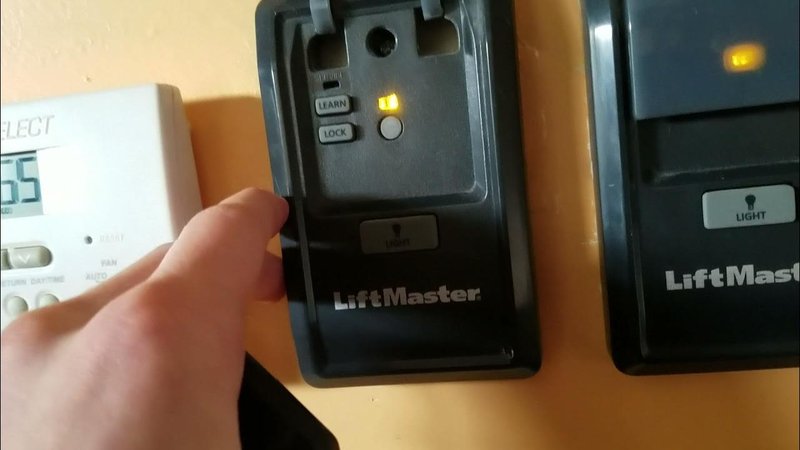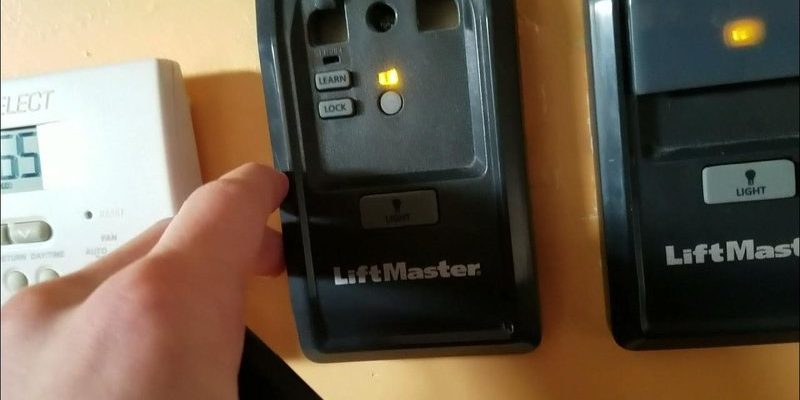
Let me paint the picture: You’re trying to program a new remote, or maybe you’re replacing batteries and now nothing works. The manual talks about a “learn” button, but there are no labels on your handheld remote. Here’s the thing—most people expect to find the learn button on the remote itself, but Chamberlain has a slightly different approach. Let’s walk through exactly where to look, what the learn button does, and why it matters for your garage setup.
Chamberlain Garage Remotes: Where to Expect the Learn Button
First off, it’s easy to assume every button needed is on the remote you hold in your hand. But with Chamberlain systems, the real magic happens on the main garage door opener—the mechanical box mounted on your garage ceiling or wall, not the little remote you carry around. The learn button never appears directly on the handheld remote. Instead, it’s located on the actual garage door opener unit itself.
Think of your remote as more like a TV remote. You press buttons, but the real action happens inside the TV. Similarly, the Chamberlain learn button is tucked away on the opener motor, often right next to where the hanging light bulb is inserted. You might need a stepladder for this one. It’s usually under a light cover or a small plastic panel, so don’t be afraid to take a closer look.
Chamberlain uses colored buttons to help identify the learn feature. You might notice a small square or round button in red, yellow, orange, green, or purple, and sometimes it’s labeled “Learn,” but not always. That’s your target. If your model doesn’t spell it out, the color cue is the best hint. It sits close to the antenna wire (a thin, hanging wire on the opener) or near the terminal screwboard.
Why the Learn Button Isn’t on the Remote
You might be wondering, “Why not put the learn button right on the remote?” Honestly, that would seem logical. But security and user safety come first. If the learn button was on the remote itself, anyone with access to your remote could easily reprogram or reset your door opener. By keeping the learn button up on the opener motor, Chamberlain makes it much harder for someone to mess with your system without your knowledge.
Another reason: electronics inside the opener itself handle all the heavy lifting, like generating and storing the unique rolling codes that pair with your remote. The learn button acts as a gatekeeper. Pushing it tells the opener to accept a new pairing or erase old codes—something you wouldn’t want to do by accident in your pocket or car.
So if you’re holding your Chamberlain remote, save yourself some time: there’s no learn button there. It’s on the opener box, usually hidden but always within reach if you know where to search.
How to Find the Learn Button on Your Chamberlain Garage Opener
Let me explain the usual step-by-step. Picture yourself in your garage, remote in one hand, eyes scanning the ceiling unit. Most Chamberlain garage door openers follow a similar design:
- Locate the main opener unit. This is the large box mounted overhead, attached to the center track of your garage door.
- Look for a light cover or plastic panel. Often, the learn button hides underneath this protective cover. You might need to pop it off or gently slide it out of the way.
- Find the antenna wire. Chamberlain units often have a short hanging wire for the wireless signal. The learn button is usually nearby.
- Spot the colored button. Check for a small circular or square button—yellow, red, green, orange, or purple. That’s the learn button.
If the opener unit is really old, it might have a black or white button instead. Sometimes, there’s a label next to it, but older models can skimp on markings. Don’t force the cover—most just snap off. Chambers with keypads outside will have the same learn button inside.
What the Chamberlain Learn Button Actually Does
Here’s the real story: the learn button is your system’s reset, sync, and pairing command center. When you press it (usually for one second), your opener listens for a nearby remote signal. That’s why it’s called “learn”—the opener is learning which remote to trust.
If you want to add a new remote, you press the learn button, then press the remote button you want to program. If you want to sync a keypad outside your garage, you do the same thing (plus an extra code step). Need to reset or erase old codes? Hold the learn button for about six seconds until the light blinks. That wipes out all paired remotes, in case you lost one or moved into a new house.
The learn button is the “accept new friends” feature of your garage door’s brain. One tap to connect, a long hold to forget everyone.
Pressing the learn button doesn’t open or close your door immediately—don’t worry about accidentally triggering anything. It simply puts the opener in a listening mode for about 30 seconds.
Common Chamberlain Remote Problems and Learn Button Fixes
Almost every garage door headache ties back to the learn button at some point. Suppose your remote suddenly stops working after a battery change, or maybe the button just flashes but nothing happens. Here’s what could be going on:
- Remote needs re-syncing. Batteries died and the rolling code lost sync. Use the learn button to re-pair your remote.
- Interference or weak signal. Sometimes, nearby electronics can mess with the signal. Resetting the connection can help.
- Your opener code memory is full. Chamberlain openers only support a limited number of remotes (usually 5–6). If you can’t program a new one, erase all codes then re-sync the remotes you still use.
- Lost or stolen remote. Hold the learn button for six seconds to wipe all old remote codes for security, then re-program your current remotes.
If you’re still having trouble, check the battery in your remote first—honestly, it’s almost always the battery. If you’ve tried everything, sometimes the opener’s logic board can fail, but that’s pretty rare.
How to Program, Sync, or Reset a Chamberlain Garage Door Remote
Programming your remote—or syncing a keypad—always requires the learn button. Here’s a step-by-step process:
- Step 1: Grab a sturdy ladder and climb up safely to the garage opener.
- Step 2: Open or slide off the light cover to expose the learn button.
- Step 3: Press and release the learn button once (don’t hold it unless you want to erase codes!).
- Step 4: Within 30 seconds, press and hold the button on your remote that you want to program.
- Step 5: Release the remote button when you see the opener light blink or hear a click.
- That’s it—your remote is paired!
If you’re resetting, hold the learn button for six seconds until the light turns off. Then, re-program any remotes as needed.
Tip: Always label your remotes or write down which button goes to which door—life gets confusing fast with multiple openers and remotes.
Comparing Chamberlain Remotes to Universal Remotes
Let’s say you bought a universal garage remote because it seemed easier or cheaper. These remotes claim to work with multiple brands, including Chamberlain. Honestly, they’re convenient, but you’ll still need to use the learn button on your Chamberlain opener to sync the universal remote. The process stays the same: find the learn button, press it, and then press the universal remote’s button.
The main difference is that universal remotes sometimes require an extra step, like a code or DIP switch adjustment. Check your universal remote manual for Chamberlain compatibility. If you have a newer Chamberlain opener with security+ 2.0 or rolling code technology, make sure your universal remote supports these features—or you’ll be stuck with a remote that won’t pair.
Universal remotes work best if you have multiple openers from different brands in one garage. If you’re a Chamberlain-only household, honestly, it’s usually simpler and more reliable to stick with Chamberlain-branded remotes.
Troubleshooting: What if You Can’t Find or Use the Learn Button?
Every once in a while, someone calls me totally stuck: “There’s no learn button! It’s not where you said!” Here’s what to check first:
- Model age: Very old Chamberlain openers (pre-1990s) may not have a learn button. Instead, they use DIP switches, tiny toggles inside the remote and opener. In that case, you’ll need to match the sequence of switches manually.
- Covered up or hidden: Sometimes paint, dirt, or an old sticker hides the button. Clean off the opener unit and check all sides.
- Broken or missing button: If the learn button fell inside the unit or physically broke, the logic board might need replacing. Not ideal, but fixable.
- Out of reach: If your opener is mounted too high, get a taller ladder or ask someone for help. Never risk your safety for this step.
When all else fails, try searching for your opener’s exact model number (usually on a sticker on the back or side) and look up that manual online. Chamberlain’s manuals almost always include a diagram of the learn button’s location.
Why the Learn Button Location Matters for Garage Security
Security is a huge part of modern garage door systems. The learn button’s location keeps your code safe from prying hands. Imagine if someone could reach through your car window and reprogram your opener—that’s what Chamberlain’s design prevents. Plus, when you move into a new house, the learn button makes it easy to wipe out all the old remotes, keeping you in control.
Without the learn button hidden away, anyone could pair a new remote to your garage door. Chamberlain’s setup makes sure only you—or someone inside your garage—can add or erase access.
If you ever suspect your code was stolen or a remote went missing, a simple long-press of the learn button puts you back in charge. No need to call a locksmith or buy a whole new system.
If you ever find yourself turning your remote upside down, searching for a learn button that just isn’t there, remember it’s all about the main opener box attached to your ceiling. The Chamberlain learn button is the key to syncing, pairing, and securing your garage door. The process is straightforward once you know where to look—usually under a light cover, marked by a distinct color, and sitting right on the opener’s surface.
Don’t let missing remotes or dead batteries stress you out. Armed with a step ladder, a little patience, and the knowledge of where the learn button hides, you can handle almost any Chamberlain garage door remote problem on your own. And if you ever feel stuck, just remember: every garage door has its quirks—but you’re not the first (or last) person to stand there, remote in hand, feeling a little lost. Now you know exactly where—and why—to look for that all-important learn button.
